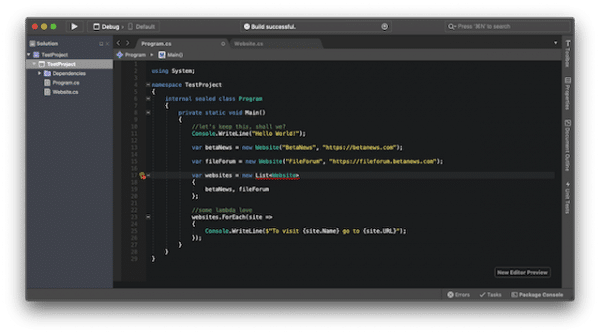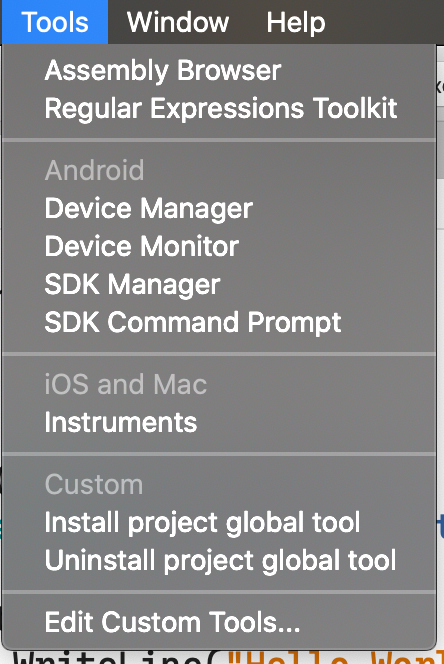


- Open .nupkg and visual studio for mac how to#
- Open .nupkg and visual studio for mac mac osx#
- Open .nupkg and visual studio for mac install#
- Open .nupkg and visual studio for mac code#
- Open .nupkg and visual studio for mac license#
Make your GitHub private to keep your license file safe. NOTE: If your GitHub repository is public you will expose your license file to everyone. Add the license file to the solution so that it will be added to the GitHub repository and downloaded to DevOps.
Open .nupkg and visual studio for mac install#
The most straightforward way to install the license is to put the babel.licenses file inside the solution folder. The babel.license file can be installed in different ways. The build failed because Babel Obfuscator needs to find the license file. Now that the Babel feed is configured, you can install the Babel Obfuscator package in the WpfLicense project.Īfter installing the package rebuild the solution. Select Package Source and add a new package source named Babel pointing to the DevOps feed URL. Copy the Babel feed URL provided and from the Visual Studio Options panel search for NuGet. Inside Visual Studio configure the new Babel package source. Nuget.exe push -Source "Babel" -ApiKey az Babel.Obfuscator.9.4.0.0.nupkg Upload to the Babel feed just created the latest version of Babel Obfuscator NuGet package you received with your Company license. If you choose NuGet you will get the instructions to upload your package and configure the feed inside Visual Studio: Then press Connect to feed button to show a list of package management tools. Go to DevOps Artifacts and Create a feed named Babel. NOTE that the Babel.Obfuscator NuGet package must be hosted on your private feed and not exposed to any public available NuGet package repository. In this case, we will create a NuGet feed to host the Babel.Obfuscator components. The DevOps Artifacts are deployable components in your application. First, you need to upload the Babel.Obfuscator NuGet package to the DevOps Artifacts. Now that the DevOps build is up and running let’s add obfuscation to our WpfLicense project. The build will start and if everything is setup correctly you will get the build succeeded email.
Open .nupkg and visual studio for mac code#
DevOps will find your YAML code and prompt to review your build script. You will be prompted to select the repository for your pipeline. Now go to the Pipeline tab and press Create pipeline button. Click project setting and select GitHub connection to connect your DevOps project to the GitHub WpfLicense repository.Īfter few click you will have your GitHub repository connected to DevOps. Login into your DevOps account and create a new project named WpfLicense. Once that we have setup our build pipeline, we are ready to link the GitHub repository to DevOps. NET Core 3 tools are installed on the DevOps virtual machines by adding the following YAML instructions to your azure-pipelines.yml file before the build task occurs:
Open .nupkg and visual studio for mac mac osx#
If you need to host your build on a Linux or MAC OSX DevOps virtual machine, Just ensure that. NET Core 3 included Linux and MAC OSX DevOps virtual machines. Babel Obfuscator supports every build system based on. NET Core application, you might want to run your build on Linux or a MAC virtual machine. publish: $(Build.ArtifactStagingDirectory)Īs we will run Visual Studio on DevOps build, we need to start the build on a Windows virtual machine.

If you have not already set up git for your project, CD into the application solution folder and enter the following commands: Let’s start by uploading the source files to GitHub.įirst, create the application private repository on GitHub.
Open .nupkg and visual studio for mac how to#
With this example, we will show how to obfuscate the application and generate a license using the Babel Licensing generation tool directly on DevOps.

NET 4.5 WPF application ( WpfLicense) that generates and validate a license file. If you are already familiar with GitHub and DevOps you can skip the following paragraph and start reading from the “ Add Babel Obfuscator to DevOps Build” paragraph. We will connect the GitHub repository to DevOps and setup Babel Obfuscator to run on every DevOps build. In this tutorial, we will start from scratch using GitHub as our source repository. Babel Obfuscator can be plugged in your DevOps build pipeline by referencing in your Visual Studio project the Babel.Obfuscator NuGet package. DevOps is the new build automation cloud-based platform provided by Microsoft.


 0 kommentar(er)
0 kommentar(er)
